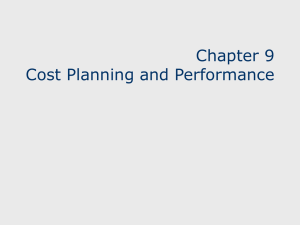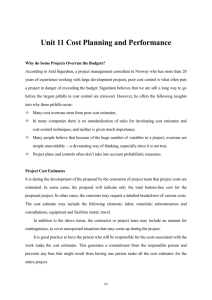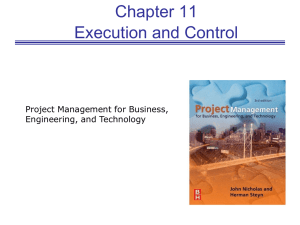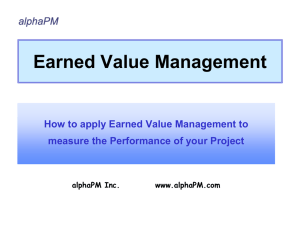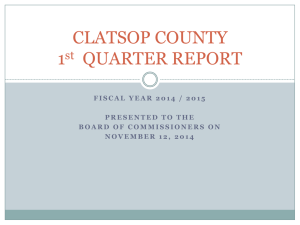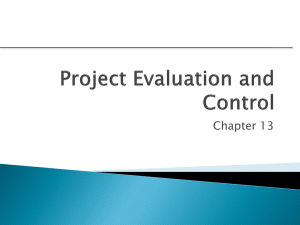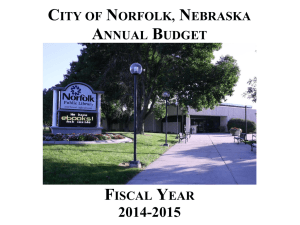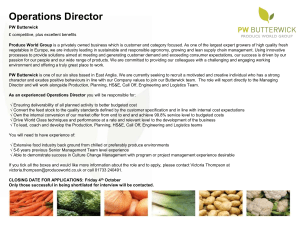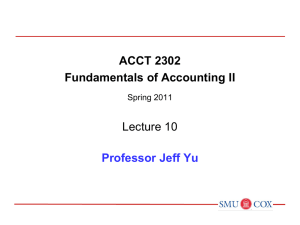Chapter 7
advertisement
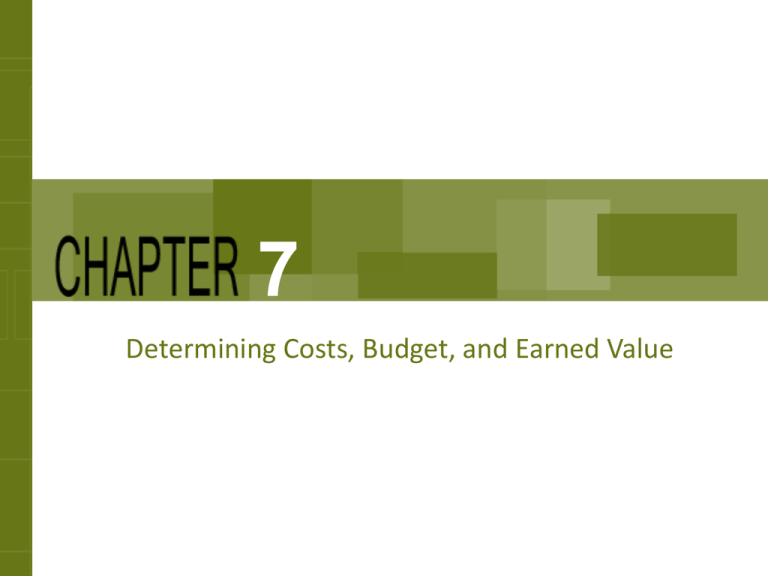
7 Determining Costs, Budget, and Earned Value Chapter Concepts Estimating the costs of activities Determining a time-phased baseline budget Determining the earned value of the work performed Analyzing cost performance Forecasting project cost at completion Controlling project costs Managing cash flow Learning Outcomes Estimate the cost of activities Aggregate the total budgeted cost Develop a time-phased baseline budget Describe how to accumulate actual costs Determine the earned value of work performed Calculate and analyze key project performance measures Discuss and apply approaches to control the project budget Explain the importance of managing cash flow Project Management Knowledge Areas from PMBOK® Guide Project Cost Management Why Cost and Schedule Overruns on Mega Oil Sands Projects? Cost Overrun Causes Lack of front-end planning Issues with procurement Failed start-up and operations of sites Human resource issues Poor organization Improperly managed project processes Lack of project control Solutions Increase risk management Develop strategies for project control, change control, communications, organization, and project responsibilities Improve contract strategies Organize the project sites Align project partners, contractors, and engineering firms TIGTA Cites Costs, Delays in IRS Modernization Background Treasury Inspector General for Tax Administration (TIGTA) monitor modernization of the Internal Revenue Service (IRS) Ongoing continued improvements Reduced operation costs Outcomes Some milestones have been completed on schedule Other milestones have been 375% over schedule Schedule delays increase costs Re-engineering has occurred resulting in reduced scope Delays have delayed start of second project Developing project management skills Estimate Activity Costs Elements Labor Materials Equipment Facilities Subcontractors and consultants Travel Contingency Good Practices Have the person responsible estimate costs Use historical data to inform current project Be reasonable and realistic Estimate near-term activities more accurately Elaborate other costs as additional information known Consumer Market Study Project Estimated Costs Aggregate Total Budgeted Cost Establish a TBC for each work package (Step 1) Determine the process Top-down Bottom-up If sum of initial estimates exceeds sponsor budget, then reduce costs and recalculate Packaging Machine Project Aggregate Total Budgeted Cost Develop Cumulative Budgeted Cost Distribute each total budgeted cost (TBC) over work package duration (Step 2) Create the time-phased budget Calculate cumulative budgeted cost Provides a baseline against which actual cost and work performance are measured Packaging Machine Project Develop Cumulative Budgeted Cost Determine budgeted cost by period Graph the cumulative budgeted cost curve Determine Actual Cost Actual Cost Collect data regularly for funds actually expended Charge to work package numbers Committed Costs Periodically assign portion of total cost to actual cost Include costs for items that will be paid for later Compare Actual Cost To Budgeted Cost Calculate cumulative actual cost Compare to cumulative budgeted cost Packaging Machine Project Determine Actual Cost End of Week 8 Planned cost = $64,000 Actual cost = $68,000 Compare CAC with CBC Determine Value of Work Performed Example Project Paint 10 similar rooms Total budgeted cost of $2,000 Budget is $200 per room At Day 5 $1,000 has been spent 3 rooms have been painted Earned value = 0.30 X $2,000 = $600 Have expended $400 more than the Earned Value Packaging Machine Project Determine Value of Work Performed Analyze Cost Performance Four cost-related measures TBC – total budgeted cost CBC – cumulative budgeted cost CAC – cumulative actual cost CEV – cumulative earned value Use to analyze project cost performance Plot CBC, CAC, and CEV curves on the same graph Reveal any trends toward improving or deteriorating cost performance Packaging Machine Project Analyze Cost Performance Cost Performance Index Measure of the cost efficiency with which the project is being performed Cost performance index = Cumulative earned value/Cumulative actual cost CPI = CEV/CAC Packaging Machine Project Cost Performance Index End of Week 8 $64,000 was budgeted $68,000 was actually expended $54,000 was the earned value of work actually performed CEV = $54,000 CAC = $68,000 Determine CPI CPI = CEV/CAC = $54,000/$68,000 = 0.79 For every $1.00 actually expended, only $0.79 of earned value was received. Cost Variance Indicator of cost performance Difference between the cumulative earned value of the work performed and the cumulative actual cost Cost variance = Cumulative earned value – Cumulative actual cost CV = CEV – CAC Packaging Machine Project Cost Variance End of Week 8 $64,000 was budgeted $68,000 was actually expended $54,000 was the earned value of work actually performed CEV = $54,000 CAC = $68,000 Determine CV CV = CEV – CAC = $54,000 – $68,000 = – $14,000 The value of the work performed through week 8 is $14,000 less than the amount actually expended. Estimate Cost at Completion Forecast what the total costs will be at the completion of the project or work package 3 different methods FCAC = TBC / CPI (assumes CPI stays the same) FCAC = CAC + (TBC – CEV) (assumes CPI returns to 1) FCAC = CAC + Re-estimate of remaining work Another method TCPI = (TBC – CEV)/(TBC – CAC) (CPI req’d to finish on budget) Packaging Machine Project Estimate Cost at Completion End of Week 8 $64,000 was budgeted $68,000 was actually expended $54,000 was the earned value of work actually performed CEV = $54,000 CAC = $68,000 CPI = 0.79 TBC = $100,000 Determine FCAC FCAC = TBC / CPI = $100,000/0.79 = $126,582 FCAC = CAC + (TBC – CEV) = $68,000 + ($100,000 – $54,000) = $68,000 + $46,000 = $114,000 TCPI = (TBC – CEV)/(TBC – CAC) = ($100,000 − $54,000)/( $100,000 − $68,000) = $46,000/$32,000 = 1.44 Control Costs Analyze cost performance on a regular basis Determine which work packages require corrective action Decide what specific corrective action Revise the project plan Evaluate negative cost variance Take corrective actions Near term activities Activities with large cost estimate Reduce costs of activities Evaluate the trade-off of cost and scope Ways to Reduce Costs of Activities Substitute less expensive materials. Assign a person with greater expertise to perform or help with the activity. Reduce the scope or requirements. Increase productivity through improved methods or technology. Manage Cash Flow Ensure that cash comes in faster than it goes out Negotiate payment terms Provide a down payment Make equal monthly payments Provide frequent payments Avoid only one payment at end of project Control outflow of cash Cost Estimating for Information Systems Development Common errors in estimating costs Underestimating the work time necessary to complete an activity Requiring rework to meet the user requirements Underestimating growth in the project scope Not anticipating new hardware purchases Making corrections to flaws in excess of the contingency planning Changing the design strategy Increasing resources to fast-track phases of the SDLC IS Example: Estimated Activity Costs Project Management Information Systems Store all costs associated with each resource Calculate the budget for each work package Determine cost for the entire project Define different rate structures for each resource Analyze cost performance Critical Success Factors Estimated activity costs must be based on the estimated activity resources. The person who will be responsible for performing the activity should estimate the costs for that activity. This generates commitment from the person. Cost estimates should be reasonable and realistic. Once the project starts, it is important to monitor actual costs and work performance to ensure that everything is within budget. A system should be established to collect, on a regular and timely basis, data on costs actually expended and committed, and the earned value (percent complete) of the work performed, so they can be compared to the cumulative budgeted cost (CBC). If at any time during the project it is determined that the project is overrunning the budget, or the value of the work performed is not keeping up with the actual amount of costs expended, corrective action must be taken immediately. Critical Success Factors (continued) It is important to use the time-phased cumulative budgeted cost (CBC), rather than the total budgeted cost (TBC), as the baseline against which cumulative actual cost (CAC) is compared. It would be misleading to compare the actual costs expended to the total budgeted cost because cost performance will always look good as long as actual costs are below the TBC. To permit a realistic comparison of cumulative actual cost to cumulative budgeted cost, portions of the committed costs should be assigned to actual costs while the associated work is in progress. The earned value of the work actually performed is a key parameter that must be determined and reported throughout the project. For each reporting period, the percent complete data should be obtained from the person responsible for the work. It is important that the person make an honest assessment of the work performed relative to the entire work scope. One way to prevent inflated percent complete estimates is to keep the work packages or activities small in terms of scope and duration. It is important that the person estimating the percent complete assess not only how much work has been performed but also what work remains to be done. Critical Success Factors (continued) The key to effective cost control is to analyze cost performance on a timely and regular basis. Early identification of cost variances (CV) allows corrective actions to be taken immediately, before the situation gets worse. For analyzing cost performance, it is important that all the data collected be as current as possible and be based on the same reporting period. Trends in the cost performance index (CPI) should be monitored carefully. If the CPI goes below 1.0 or gradually decreases, corrective action should be taken. As part of the regular cost performance analysis, the estimated or forecasted cost at completion (FCAC) should be calculated. The key to effective cost control is to aggressively address work packages or activities with negative cost variances and cost inefficiencies as soon as they are identified. A concentrated effort must be applied to these areas. The amount of negative cost variance should determine the priority for applying these concentrated efforts. Critical Success Factors (continued) When attempting to reduce negative cost variances, focus on activities that will be performed in the near term and on activities that have large estimated costs. Addressing cost problems early will minimize the negative impact on scope and schedule. Once costs get out of control, getting back within budget becomes more difficult and is likely to require reducing the project scope or quality, or extending the project schedule. The key to managing cash flow is to ensure that cash comes in faster than it goes out. It is desirable to receive payments (cash inflow) from the customer as early as possible, and to delay making payments (cash outflow) to suppliers or subcontractors as long as possible. Summary The total project cost is often estimated during the initiating phase of the project when the project charter or a proposal is prepared, but detailed plans are not usually prepared at that time. The project budgeting process involves two steps: the budget for each work package is determined and the budget for each work package is then distributed over the expected time. Aggregating the estimated costs of the specific activities for the appropriate work packages in the work breakdown structure will establish a total budgeted cost (TBC). The cumulative budgeted cost (CBC) is the time-phased baseline budget that will be used to analyze the cost performance of the project. At any time during the project, it is possible to forecast what the total costs will be at the completion of the project or work package based on analysis of actual cost expended and the earned value of work performed. The key to effective cost control is to analyze cost performance on a regular and timely basis. It is important to manage the cash flow on a project. Appendix (is testable!) Time-Cost Trade-Off Each activity can have two pairs of duration and cost estimates Normal time and cost Time to complete under normal conditions Cost if done in normal time Crash time and cost Shortest possible length to complete the activity Cost if done in crash time Time-Cost Trade-Off (cont.) Assumptions Activity duration can be shortened by applying more resources with an associated cost Crash time is the shortest possible duration Resources for acceleration are available Relationship between time and cost is linear Crash cost – Normal Cost cost per time period -----------------------------Normal time – Crash time A: Max accel: Cost/wk: B: Max accel: Cost/wk C: Max accel: Cost/wk: D: Max accel: Cost/wk: A: Max accel: Cost/wk: B: Max accel: Cost/wk 2 weeks $6k 3 weeks $10k C: Max accel: 1 week Cost/wk: $5k D: Max accel: 2 weeks Cost/wk: $6k Time-Cost Trade-Off (cont.) Objective of time-cost trade-off Determine shortest completion time By crashing activities with smallest cost increase Method: Shorten project duration one period at a time Crash only activities on critical path(s) with lowest cost per period increase Until get shortest possible project completion time 23 Project duration: 18 weeks Project cost: $200,000 $6k/period $10k/period $5k/period $6k/period Reduce by 1 wk CP: Which activity to accelerate: New duration: New cost: Project duration: 18 weeks Project cost: $200,000 $6k/period $10k/period $5k/period $6k/period Reduce by 1 wk CP: C-D Which activity to accelerate: C New duration: 17 New cost: $205,000 Project duration: 17 weeks Project cost: $205,000 $6k/period $10k/period N=9 $5k/period Reduce by 1 wk CP: Which activity to accelerate: New duration: New cost: $6k/period Project duration: 17 weeks Project cost: $205,000 $6k/period $10k/period N=9 $5k/period $6k/period Reduce by 1 wk CP: C-D Which activity to accelerate: D New duration: 16 New cost: $211,000 Project duration: 16 weeks Project cost: $211,000 $6k/period N=9 N=7 $5k/period Reduce by 1 wk CP: Which activity to accelerate: New duration: $10k/period New cost: $6k/period Project duration: 16 weeks Project cost: $211,000 $6k/period $10k/period N=9 N=7 $5k/period $6k/period Reduce by 1 wk CP: A-B and C-D Which activity to accelerate: A and D New duration: 15 wks New cost: $223,000 Project duration: 15 weeks Project cost: $223,000 N=6 $6k/period N=9 N=6 $5k/period Reduce by 1 wk CP: Which activity to accelerate: New duration: $10k/period New cost: $6k/period
